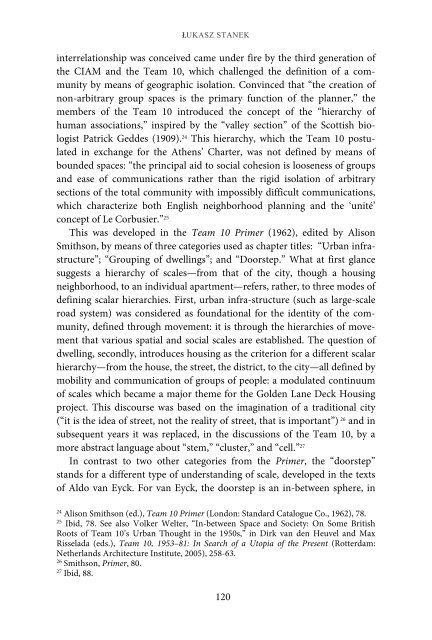Foucault, Biopolitics, and Governmentality
Foucault, Biopolitics, and Governmentality
Foucault, Biopolitics, and Governmentality
You also want an ePaper? Increase the reach of your titles
YUMPU automatically turns print PDFs into web optimized ePapers that Google loves.
ŁUKASZ STANEK<br />
interrelationship was conceived came under fire by the third generation of<br />
the CIAM <strong>and</strong> the Team 10, which challenged the definition of a community<br />
by means of geographic isolation. Convinced that “the creation of<br />
non-arbitrary group spaces is the primary function of the planner,” the<br />
members of the Team 10 introduced the concept of the “hierarchy of<br />
human associations,” inspired by the “valley section” of the Scottish biologist<br />
Patrick Geddes (1909). 24 This hierarchy, which the Team 10 postulated<br />
in exchange for the Athens’ Charter, was not defined by means of<br />
bounded spaces: “the principal aid to social cohesion is looseness of groups<br />
<strong>and</strong> ease of communications rather than the rigid isolation of arbitrary<br />
sections of the total community with impossibly difficult communications,<br />
which characterize both English neighborhood planning <strong>and</strong> the ‘unité’<br />
concept of Le Corbusier.” 25<br />
This was developed in the Team 10 Primer (1962), edited by Alison<br />
Smithson, by means of three categories used as chapter titles: “Urban infrastructure”;<br />
“Grouping of dwellings”; <strong>and</strong> “Doorstep.” What at first glance<br />
suggests a hierarchy of scales—from that of the city, though a housing<br />
neighborhood, to an individual apartment—refers, rather, to three modes of<br />
defining scalar hierarchies. First, urban infra-structure (such as large-scale<br />
road system) was considered as foundational for the identity of the community,<br />
defined through movement: it is through the hierarchies of movement<br />
that various spatial <strong>and</strong> social scales are established. The question of<br />
dwelling, secondly, introduces housing as the criterion for a different scalar<br />
hierarchy—from the house, the street, the district, to the city—all defined by<br />
mobility <strong>and</strong> communication of groups of people: a modulated continuum<br />
of scales which became a major theme for the Golden Lane Deck Housing<br />
project. This discourse was based on the imagination of a traditional city<br />
(“it is the idea of street, not the reality of street, that is important”) 26 <strong>and</strong> in<br />
subsequent years it was replaced, in the discussions of the Team 10, by a<br />
more abstract language about “stem,” “cluster,” <strong>and</strong> “cell.” 27<br />
In contrast to two other categories from the Primer, the “doorstep”<br />
st<strong>and</strong>s for a different type of underst<strong>and</strong>ing of scale, developed in the texts<br />
of Aldo van Eyck. For van Eyck, the doorstep is an in-between sphere, in<br />
24 Alison Smithson (ed.), Team 10 Primer (London: St<strong>and</strong>ard Catalogue Co., 1962), 78.<br />
25 Ibid, 78. See also Volker Welter, “In-between Space <strong>and</strong> Society: On Some British<br />
Roots of Team 10’s Urban Thought in the 1950s,” in Dirk van den Heuvel <strong>and</strong> Max<br />
Risselada (eds.), Team 10, 1953–81: In Search of a Utopia of the Present (Rotterdam:<br />
Netherl<strong>and</strong>s Architecture Institute, 2005), 258-63.<br />
26 Smithson, Primer, 80.<br />
27 Ibid, 88.<br />
120


